
Grindelia: planting, growing, and care
Contents
Grindelias in a nutshell
- Grindelias are little-known ornamental plants, native to America.
- From July to September-October, they bear bright yellow heads, very luminous.
- They are highly resistant to drought.
- These plants are perfect for rockeries, gravel gardens, slopes, sunny borders, and naturalistic gardens.
- Their flowering is melliferous, appreciated by bees and butterflies.
The Grindelias in a nutshell
Grindelias are hardy perennials, annuals, or undershrubs native to the Americas and still relatively unknown in France. It is rare to see them in gardens, although they offer a stunning display of golden-yellow flower heads from mid-summer to early autumn. Their flowers resemble those of other Asteraceae, such as daisies, fleabanes, and asters. They are distinguished by their spiny bracts, which give the flower a unique style. They are beloved by pollinating insects, such as bees and butterflies, which come to forage on them.
Grindelias are full-sun plants, ideal for greening challenging landscapes, as they thrive in dry and poor soils, even sandy and rocky ones. Moreover, they are quite hardy, able to withstand temperatures as low as -15 to -20°C. Once established, grindelias require very little maintenance! They blend effortlessly into naturalistic gardens, rockeries, slopes, sunny borders, and gravel gardens. In the garden, they pair beautifully with other plants suited to dry and sunny conditions: eryngiums, centranthus, gauras, sedums, achilleas, verbascums…
Botany
Botanical data
- Latin name Grindelia sp.
- Family Asteraceae
- Common name gumweed, grindelia, resinweed
- Flowering from July to October
- Height up to 1.50 m
- Exposure full sun
- Soil type well-drained, rather dry and poor, even sandy or stony
- Hardiness -15 to -20 °C
Grindelias or gumweeds comprise a total of 73 species of perennial plants, annuals, or undershrubs, native to North, Central, and South America. They typically grow in hot and dry conditions, along roadsides, in rocky areas, on dry slopes, wastelands, etc. They are still relatively unknown in France and rarely cultivated in gardens, despite their ornamental qualities, with bright flowering that easily fits into naturalistic gardens, rockeries, and dry gardens. These are generally hardy plants, capable of withstanding temperatures as low as -15 to -20 °C in well-drained soil.
Grindelia belongs to the large Asteraceae family, which includes over 23,000 species, such as daisies and dandelions, as well as many ornamental flowers cultivated in gardens: asters, marguerites, gazanias, sunflowers, rudbeckias, marigolds, calendulas… These plants are characterised by their inflorescences in heads: what is commonly considered a single flower is actually a multitude of tiny flowers grouped on the same floral receptacle.
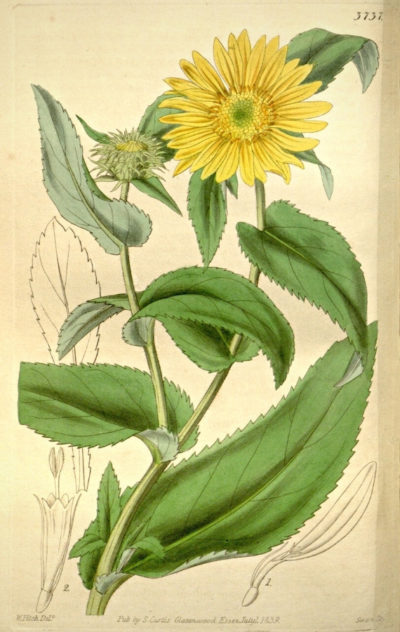
Grindelia inuloides: Botanical illustration
Grindelia was named in 1807 by Wildenow (director of the Berlin Botanical Garden) in honour of the Russian botanist and physician David Hieronymus Grindel. Grindelia is nicknamed Gumweed in English, which can be translated as “resinweed” or “gum plant,” referring to the sticky resin that covers the flower buds.
Depending on the species, grindelias exhibit quite variable habits, with upright or spreading stems, or even creeping ones (like Grindelia stricta var. platyphylla), but they are generally well-branched, giving the plant a very natural, somewhat sprawling style. They can measure between 15 cm (for ground-covering species) and up to 1.50 m in height. Their stems are often well-branched and sometimes take on a reddish hue.
Grindelias typically flower from July to October. The flower buds are notably covered in abundant, sticky resin, making them shiny. They then open to reveal golden-yellow heads, resembling daisies or dandelions, typical inflorescences of the Asteraceae family. What is perceived as a single flower is actually a head inflorescence, composed of two types of tiny flowers grouped on the same receptacle: the ligulate flowers on the periphery, with a long petal, and the tubular flowers at the centre, with small petals fused into a tube.
The heads, 4 to 7 cm in diameter, are borne at the top of the flowering stems and are usually solitary but can also be grouped in corymbs. They are surrounded by numerous overlapping bracts, long and slender, with recurved tips. Highly visible and quite decorative, they form a green, spiky swelling beneath the head, as if bristling with spikes.
Grindelias are melliferous plants, producing nectar appreciated by pollinating insects such as bees, butterflies, and hoverflies. You can pair them with other melliferous plants in a naturalistic meadow (thistles, sunflowers, cornflowers, catmints, sages, vervains…), creating a garden that supports biodiversity, providing food and shelter for insects.
The leaves of Grindelia are long and slender, lanceolate, with finely toothed leaf margins. They measure 20 to 35 cm long and have a rather ordinary wild plant appearance. They are arranged alternately on the stems (one leaf after another) and are evergreen. Like the flower buds, Grindelia leaves are dotted with glands that produce sticky resin, earning the plant its nickname of gumweed. The stems bearing them sometimes take on a beautiful reddish hue, contrasting with the green foliage.
The fruits of grindelia are oblong achenes topped with a pappus (a group of bristles allowing the seed to disperse, like a parachute), similar to dandelions. They are wind-dispersed.
Grindelia robusta has medicinal properties, concentrated mainly in its resin. It has antispasmodic, anti-inflammatory, and expectorant properties. It benefits the respiratory system and is said to be effective against coughs, bronchitis, and asthma. The flowers are used, primarily in infusions. They can also be used in mother tinctures, capsules, or homeopathic granules.
These properties were already known to Native Americans, who traditionally used the roots of Grindelia robusta to treat liver ailments and the resin for ENT conditions.

Grindelia flowers are characterised by: resin-covered flower buds (first photo), heads composed of numerous tiny tubular and ligulate flowers (second photo), and long, slender, hook-shaped bracts (third photo). Here, the species Grindelia integrifolia (photo: Doug Murphy), Grindelia robusta, and Grindelia camporum (photo: Joe Decruyenaere)
The main varieties of Grindelia
The Most Popular Varieties
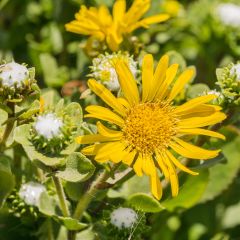
Grindelia camporum
- Flowering time August to November
- Height at maturity 1,50 m
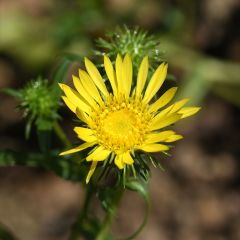
Grindelia integrifolia
- Flowering time August to November
- Height at maturity 1,50 m
Discover other Grindelia
View all →Available in 1 sizes
Available in 1 sizes
Planting
Where to Plant?
Grindelias are plants that thrive in warmth: they prefer full sun, in well-drained, rather dry soil, even sandy or stony. They grow in poor, low-fertility soils. These are ideal perennials for challenging soils, where other plants struggle to grow. Most grindelias dislike wet soils in winter, which could cause their roots to rot, with the exception of Grindelia integrifolia, which naturally grows along riverbanks, in wet meadows and marshes. Tolerant of salt and sea spray, it is perfect for coastal gardens.
Grindelias fit easily into sunny rockeries and gravel gardens, alongside other sun-loving and dry-soil plants, such as eryngiums, centranthus, sedums, lavenders, verbascums… They can also be used to cover a slope or be incorporated into a sunny border or naturalistic garden.
When to Plant?
Plant grindelia in spring, in April-May, or in autumn, around October. Plant during mild weather, avoiding frost and extreme heat, which are less favourable for establishing young plants.
How to Plant?
You can plant several together, but space them at least 50 cm apart.
- Once you’ve chosen the location, dig a planting hole, two to three times the size of the root ball.
- Don’t hesitate to mix coarse sand or gravel into the soil to improve drainage.
- Remove the grindelia from its pot and place it in the centre of the planting hole, ensuring the collar is level with the soil.
- Fill in by replacing soil around it and lightly firm it down.
- Water thoroughly.
Continue watering in the weeks after planting, until they are well established and have developed their root system.
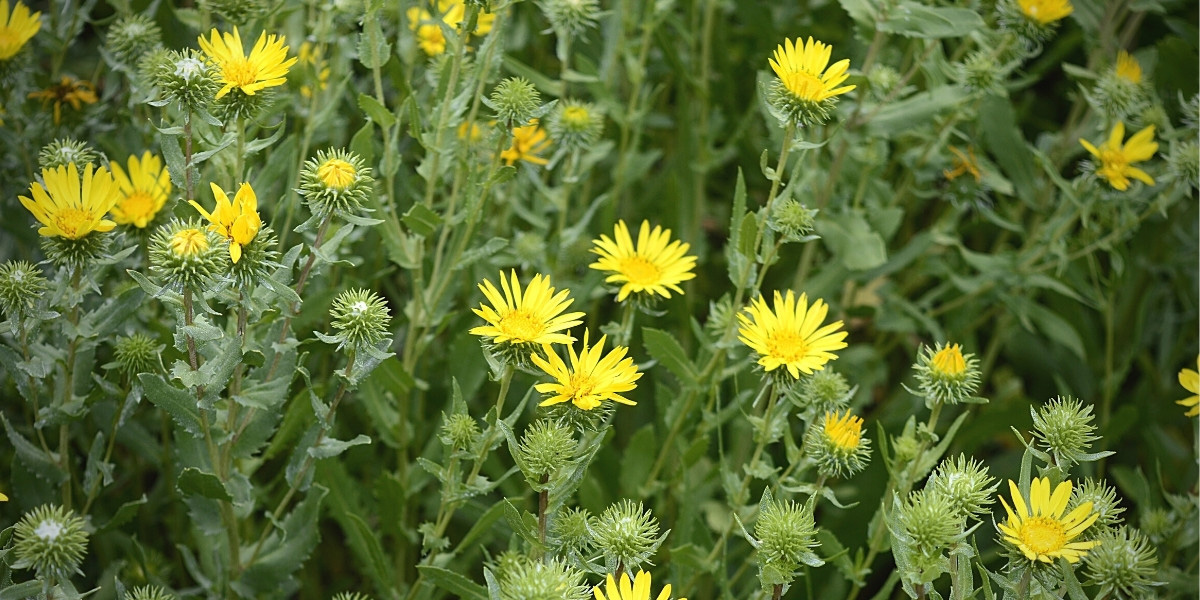
Grindelia squarrosa
Maintenance
Once planted in the garden, grindelias require very little maintenance: they thrive in dry, well-draining soil and generally won’t need watering, except during the first year after planting and in prolonged dry spells. Direct the water at the base of the plant, avoiding wetting the foliage. Apart from Grindelia integrifolia, other species are sensitive to winter moisture: you can protect them from rain by sheltering them with a transparent plastic or glass sheet.
We recommend pruning dry or damaged stems as you notice them, especially at the end of winter. Similarly, don’t hesitate to remove faded flowers regularly, both for aesthetic reasons and to encourage the emergence of new blooms.
Grindelias are rarely affected by diseases or parasites.
If you’re growing Grindelia robusta for its medicinal properties, harvest the heads in summer, around July, at the start of flowering. They should be closed or just beginning to open. Then, dry them to use in herbal teas.
Multiplication
Grindelia is primarily propagated by sowing, but it is also possible to take semi-hardwood cuttings in summer.
Sowing
Sow the seeds in late winter to early spring, under cover.
- Prepare pots with a fine, well-draining substrate, such as a special seed compost.
- Lightly firm and level the surface.
- Place the seeds on the surface.
- Cover them with a thin layer of special seed compost.
- Water gently with a fine spray.
- Place the pots in a warm, bright spot, out of direct sunlight, ideally at a temperature between 16 and 20 °C.
- Ensure the substrate remains slightly moist until germination.
Grindelia usually germinates within two to three weeks, though this may vary depending on the temperature. Once the seedlings are large enough to handle, transplant them into individual pots.
Propagation by Cuttings
You can take cuttings in summer, around August.
- Select a healthy, semi-hardwood stem, 10 to 15 cm long. Cut just below a node (the point where leaves attach to the stem), making a clean cut with a sharp, clean knife.
- If the stem has flowers or flower buds, remove them. Also, strip the leaves from the lower half of the stem, leaving only a few at the top.
- Prepare a pot with a fine, well-draining substrate, such as special seed compost.
- Water it thoroughly to ensure it is moist.
- Insert the stem into the substrate.
- Firm the substrate around the stem to ensure good contact and eliminate air pockets.
- Place the pot in a bright, sheltered spot, out of direct sunlight.
Keep the substrate slightly moist until the cutting takes root. To increase your chances of success, we recommend taking several cuttings at the same time.
Association
Grindelia, particularly Grindelia camporum, will thrive in a sunny rock garden or a scree garden. Pair it with other dry-soil plants, such as pinks, rose campion Lychnis coronaria, eryngiums, and red valerian. The striking yellow flower spikes of Verbascum ‘Polarsommer’ will add rhythm and height to the bed, creating a contrast with the unstructured look of grindelia and rose campion. At the front of the bed, place small ground-covering plants like Corsican spurge (Euphorbia myrsinites) and sedums. Also consider Mediterranean perennials such as lavender, thyme, rosemary, santolina, rockroses, and sunroses. Bringing together water-wise and low-nutrient plants, this garden will require minimal maintenance!
For more ideas, check out our inspiration page “Dry Terrain” as well as our advice sheet “10 Drought-Resistant Perennial Plants for a No-Water Garden”.
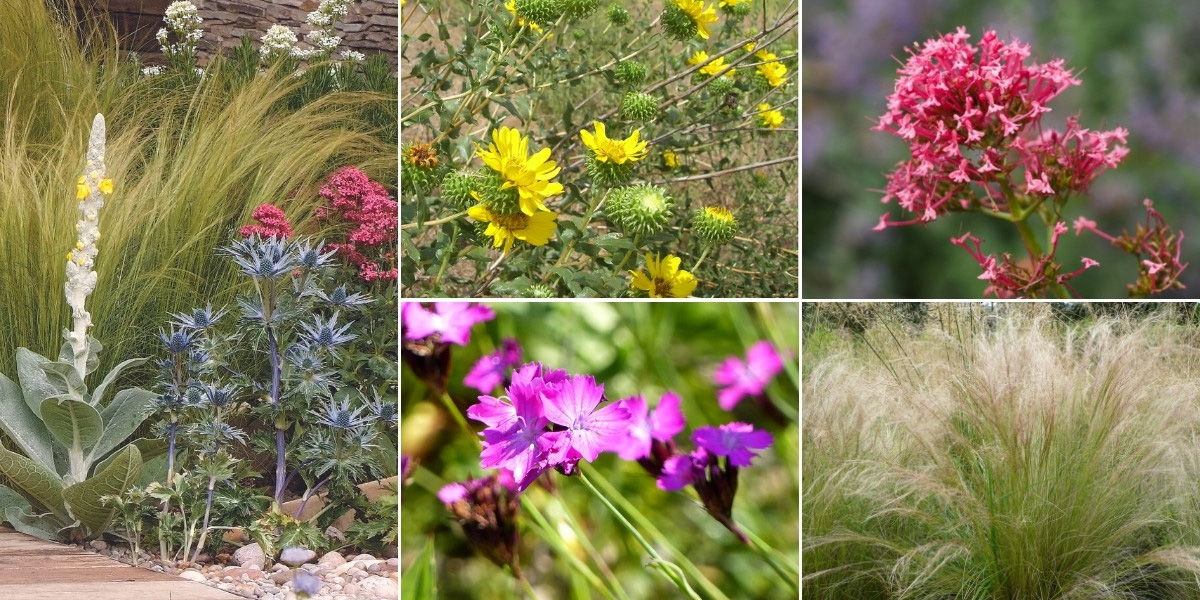
Scene featuring Verbascum ‘Polarsommer’, Eryngium oliverianum, Centranthus, Salvia ‘Caradonna’, Stipa tenuifolia (photo: Nathalie Pasquel – MAP – Landscape Designer Robert Myers), Grindelia camporum (photo Joe Decruyenaere), Centranthus ruber, Dianthus carthusianorum, and Stipa tenuifolia
With its yellow flower heads and untidy habit, Grindelia fits perfectly into naturalistic gardens! Pair it with other plants featuring delicate, airy blooms, such as gaura, purpletop vervain, penstemons, asters, and coneflowers. Also consider ornamental grasses, such as fountain grass and feather grass, essential for their light foliage and silky flower spikes in this garden style. Finally, enjoy the exceptional graphic quality of the flowers of wild teasel, Dipsacus fullonum.
Discover our inspiration page “Naturalistic Garden”.
→ Explore more beautiful pairing ideas with Grindelia in our advice sheet!
Also worth reading
- Discover our range of Grindelia
- To pair them, choose from our selection of plants for dry gardens
- Our advice sheets « Creating a rockery: our tips for success » and « 15 plants to design a sunny rockery »
- Subscribe!
- Contents

































Comments